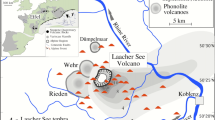Abstract.
Detailed field and microstructural studies have been combined with high spatial resolution ultraviolet laser 40Ar/39Ar dating of naturally deformed K-feldspar to investigate the direct relationship between deformation-related microstructure and Ar isotope systematics. The sample studied is a ~1,000 Ma Torridonian arkose from Skye, Scotland, that contains detrital feldspars previously metamorphosed at amphibolite-facies conditions ~1,700 Ma. The sample was subsequently deformed ~430 Ma ago during Caledonian orogenesis. The form and distribution of deformation-induced microstructures within three different feldspar clasts has been mapped using atomic number contrast and orientation contrast imaging, at a range of scales, to identify intragrain variations in composition and lattice orientation. These variations have been related to thin section and regional structural data to provide a well-constrained deformation history for the feldspar clasts. One hundred and forty-three in-situ 40Ar/39Ar analyses measured using ultraviolet laser ablation record a range of apparent ages (317–1030 Ma). The K-feldspar showing the least strain records the greatest range of apparent ages from 420–1,030 Ma, with the oldest apparent ages being found close to the centre of the feldspar away from fractures and the detrital grain boundary. The most deformed K-feldspar yields the youngest apparent ages (317–453 Ma) but there is no spatial relationship between apparent age and the detrital grain boundary. Within this feldspar, the oldest apparent ages are recorded from orientation domain boundaries and fracture surfaces where an excess or trapped 40Ar component resides. Orientation contrast images at a similar scale to the Ar analyses illustrate a significant deformation-related microstructural difference between the feldspars and we conclude that deformation plays a significant role in controlling Ar systematics of feldspars at both the inter- and intragrain scales even at relatively low 'bulk' strains. The data show that Ar loss and trapping within the deformed K-feldspars reflects the presence of a deformation-induced population of small diffusion domains in combination with 'short-circuit' diffusion along deformation-induced defects. The complex history of microstructures induced in the K-feldspars during their cooling, alteration, erosion and sedimentation do not appear to be as significant as deformation-induced microstructures in controlling the distribution of apparent ages at the grain scale.
Similar content being viewed by others
Author information
Authors and Affiliations
Additional information
Electronic Publication
Electronic Supplementary Material
Rights and permissions
About this article
Cite this article
Reddy, S.M., Potts, G.J. & Kelley, S.P. 40Ar/39Ar ages in deformed potassium feldspar: evidence of microstructural control on Ar isotope systematics. Contrib Mineral Petrol 141, 186–200 (2001). https://doi.org/10.1007/s004100000227
Received:
Accepted:
Published:
Issue Date:
DOI: https://doi.org/10.1007/s004100000227




